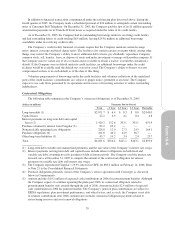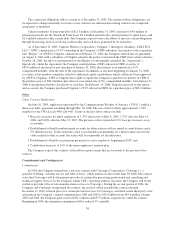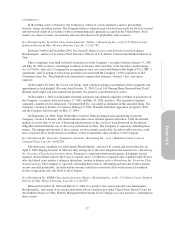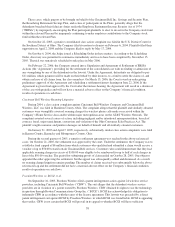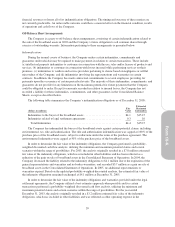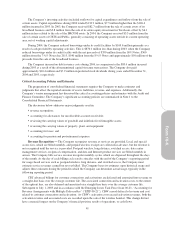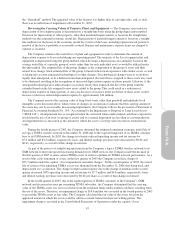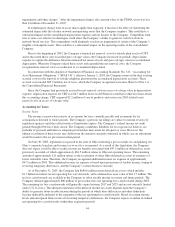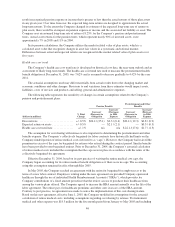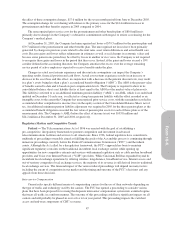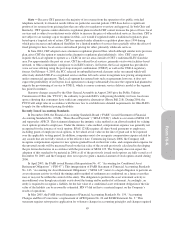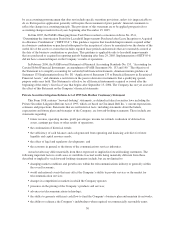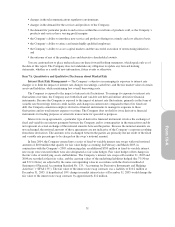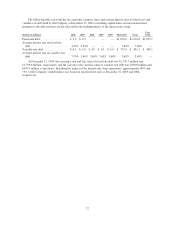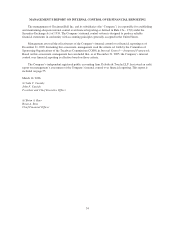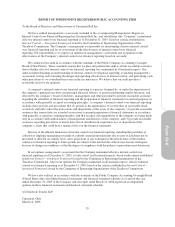Cincinnati Bell 2005 Annual Report Download - page 95
Download and view the complete annual report
Please find page 95 of the 2005 Cincinnati Bell annual report below. You can navigate through the pages in the report by either clicking on the pages listed below, or by using the keyword search tool below to find specific information within the annual report.
In addition to the federal tax net operating loss carryforwards, the Company has state and local net operating
loss carryforwards with a deferred tax asset value of $205.6 million and deferred tax temporary differences and
other tax attributes of $47.2 million. A valuation allowance of $183.9 million is provided at December 31, 2005
against certain state and local net operating losses and other deferred tax assets due to the uncertainty of the
Company’s ability to utilize the assets within the statutory expiration period.
The Company determines its effective tax rate by dividing its income tax expense by its income before taxes
as reported in its Consolidated Statement of Operations. For reporting periods prior to the end of the Company’s
fiscal year, the Company records income tax expense based upon an estimated annual effective tax rate. This rate
is computed using the statutory tax rate and an estimate of annual net income adjusted for an estimate of
non-deductible expenses.
The Company’s effective tax rate in 2005 was adversely affected by the $47.5 million income tax expense
associated with the change in Ohio tax law noted above, as well as by the non-deductible interest expense related
to securities originally issued to acquire its broadband business (the “Broadband Securities”) or securities which
the Company has subsequently issued to refinance the Broadband Securities. As a result of these items, the
Company recorded income tax expense of $54.3 million even though it had a loss before income taxes of $10.2
million.
Refer to Note 12 to the Consolidated Financial Statements for further information regarding the Company’s
income taxes.
Operating taxes
The Company incurs certain operating taxes that are reported as expenses in operating income, such as
property, sales, use, and gross receipts taxes. These taxes are not included in income tax expense because the
amounts to be paid are not dependent on the level of income generated by the Company. The Company also
records expense against operating income for the establishment of liabilities related to certain operating tax audit
exposures. These liabilities are established based on the Company’s assessment of the probability of payment.
Upon resolution of audit, any remaining liability not paid is released and increases operating income. The
Company recognized $14.4 million of income in 2005 upon resolution of certain operating tax audits, net of new
liabilities established, of which $11.2 million was associated with the Broadband segment. Refer to Note 14 to
the Consolidated Financial Statements. Additionally, the Company recognized $4.4 million and $0.2 million of
income in 2004 and 2003, respectively, upon resolution of operating tax audits, net of new liabilities established.
Accounting for Pension and Postretirement Expenses — The Company sponsors three noncontributory
defined benefit pension plans: one for eligible management employees, one for non-management employees and
one supplemental, nonqualified, unfunded plan for certain senior executives. The Company also provides health
care and group life insurance benefits for eligible retirees. The key assumptions used to account for the plans are
disclosed in Note 8 to the Consolidated Financial Statements. The actuarial assumptions attempt to anticipate
future events and are used in calculating the expenses and liabilities related to these plans. The most significant
of these numerous assumptions, which are reviewed annually, include the discount rate, expected long-term rate
of return on plan assets and health care cost trend rates.
Discount rate
A discount rate is selected annually to measure the present value of the benefit obligations. In determining
the selection of a discount rate, the Company estimates the timing and amounts of expected future benefit
payments and applies a yield curve developed to reflect yields available on high-quality bonds. Based on the
analysis, the discount rate was set at 5.50% for all of the plans as of December 31, 2005. At December 31, 2004,
the discount rates were set at 5.50% and 5.75% for the pension plans and postretirement plans, respectively.
Expected rate of return
The expected long-term rate of return on plan assets, developed using the building block approach, is based
on the following: the participant’s benefit horizons; the mix of investments held directly by the plans, which is
generally 60% equities and 40% bonds; and, the current view of expected future returns, which is influenced by
historical averages. The required use of an expected versus actual long-term rate of return on plan assets may
45


